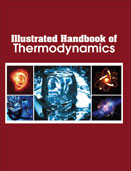Handbooks

Thermodynamics is the branch of physics that deals with the relationships between heat and other forms of energy. In particular, it describes how thermal energy is converted to and from other forms of energy and how it affects matter. This guide focuses largely on how a heat transfer is related to various energy changes within a physical system undergoing a thermodynamic process. Such processes usually result in work being done by the system and are guided by the laws of thermodynamics.
In science, thermodynamics is the study of the conversion of heat into work through the intermediate cyclical actions of a system. Thermodynamics is an important part of physics, chemistry, and engineering. Therefore, it is a critical area of study for those in science and technology. Thermodynamics also finds importance in ecology, energy, and other studies. In addition analogous concepts are used in information theory/computer science and even social sciences.
Illustrated Handbook of Thermodynamics is intended to present a thorough, concise and accurate discussion of fundamentals and principles of thermodynamics. It also describes several approaches on thermodynamics and illustrates these to problems dealing with properties of materials and phase transformations. Thermodynamics is considered to be one of the most important parts of our day-to-day life. Whether you are travelling in any vehicle, sitting comfortably in your air-conditioned room, watching television etc, you will notice the applications of thermodynamics almost everywhere directly or indirectly. When Sadi Carnot proposed his theory, anybody had imagined that his proposals will play such a major role in creation of automobiles that would become one of most important parts of the human life. The development of almost all types of engines can be traced to the Carnot Theorem and Carnot Cycle. At this stage of our life can we imagine the life without automobiles? Of course one cannot forget the importance of Stirling, Diesel, Otto and Ericsson also created their own independent cycles that resulted in more innovations and betterment of the automobiles. The study of the thermodynamics involves system and surroundings where all the experimentation is done for the discovery of the device. There are various types of thermodynamic processes that help implementing thermodynamic laws for various thermodynamic applications. The Laws of Thermodynamics are important because they control interactions of everything in the universe - regardless of scale. These rules stretch across every form of science known to humankind.
Illustrated Handbook of Thermodynamics provides engineers with the concepts, tools, and experience needed to solve practical real-world energy problems. The aim of this Handbook is to help students and researchers develop a practical, systems-based understanding of thermodynamics.